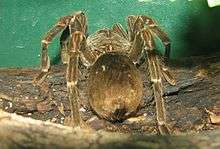Pamphobeteus
Pamphobeteus is a genus of tarantulas that was first described by Reginald Innes Pocock in 1901.[2] It includes some of the largest spiders in the world.
| Pamphobeteus | |
|---|---|
 | |
| Pamphobeteus nigricolor | |
| Scientific classification | |
| Kingdom: | Animalia |
| Phylum: | Arthropoda |
| Subphylum: | Chelicerata |
| Class: | Arachnida |
| Order: | Araneae |
| Infraorder: | Mygalomorphae |
| Family: | Theraphosidae |
| Genus: | Pamphobeteus Pocock, 1901[1] |
| Type species | |
| P. nigricolor (Ausserer, 1875) | |
| Species | |
|
13, see text | |
This genus was split from Lasiodora, distinguished by the lack of scopulae on the inferior side of the first leg femur and the differences in the organ for stridulation.[3]
Species
As of May 2020 it contains thirteen species, endemic to northwestern South America and Panama:[1]
- Pamphobeteus antinous Pocock, 1903 – Peru, Bolivia
- Pamphobeteus augusti (Simon, 1889) – Ecuador
- Pamphobeteus crassifemur Bertani, Fukushima & Silva, 2008 – Brazil
- Pamphobeteus ferox (Ausserer, 1875) – Colombia
- Pamphobeteus fortis (Ausserer, 1875) – Colombia
- Pamphobeteus grandis Bertani, Fukushima & Silva, 2008 – Brazil
- Pamphobeteus insignis Pocock, 1903 – Colombia
- Pamphobeteus nigricolor (Ausserer, 1875) (type) – Colombia, Brazil
- Pamphobeteus ornatus Pocock, 1903 – Panama, Colombia
- Pamphobeteus petersi Schmidt, 2002 – Ecuador, Peru
- Pamphobeteus ultramarinus Schmidt, 1995 – Ecuador
- Pamphobeteus verdolaga Cifuentes, Perafán & Estrada-Gomez, 2016 – Colombia
- Pamphobeteus vespertinus (Simon, 1889) – Ecuador
Formerly included:
- P. benedeni (Bertkau, 1880) (Transferred to Lasiodora)
- P. cephalopheus Piza, 1944 (Transferred to Vitalius)
- P. communis Piza, 1939 (Transferred to Vitalius)
- P. litoralis Piza, 1976 (Transferred to Vitalius)
- P. masculus Piza, 1939 (Transferred to Vitalius)
- P. mus Piza, 1944 (Transferred to Vitalius)
- P. piracicabensis Piza, 1933 (Transferred to Vitalius)
- P. striatus Schmidt & Antonelli, 1996 (Transferred to Lasiodorides)
- P. urbanicolus Soares, 1941 (Transferred to Vitalius)
- P. ypiranguensis Soares, 1941 (Transferred to Vitalius)
gollark: God(s) obviously cannot not listen now.
gollark: The computer is currently doing about 70 million prayers per second.
gollark: Yes.
gollark: Muahahahaha.
gollark: I can have my computer do a few million prayers per second, if it helps.
See also
References
- "Gen. Pamphobeteus Pocock, 1901". World Spider Catalog Version 20.0. Natural History Museum Bern. 2020. doi:10.24436/2. Retrieved 2020-06-06.
- Pocock, R. I. (1901). "Some new and old genera of S.-American Avicularidae". Annals and Magazine of Natural History. 8 (7): 540–555.
- Bertani, Rogério; Fukushima, Caroline Sayuri & da Silva Júnior, Pedro Ismael (2008). "Two new species of Pamphobeteus Pocock, 1901 (Araneae: Mygalomorphae: Theraphosidae) from Brazil, with a new type of stridulatory organ" (PDF). Zootaxa. 1826: 45–58. Retrieved 2016-05-21.
This article is issued from Wikipedia. The text is licensed under Creative Commons - Attribution - Sharealike. Additional terms may apply for the media files.